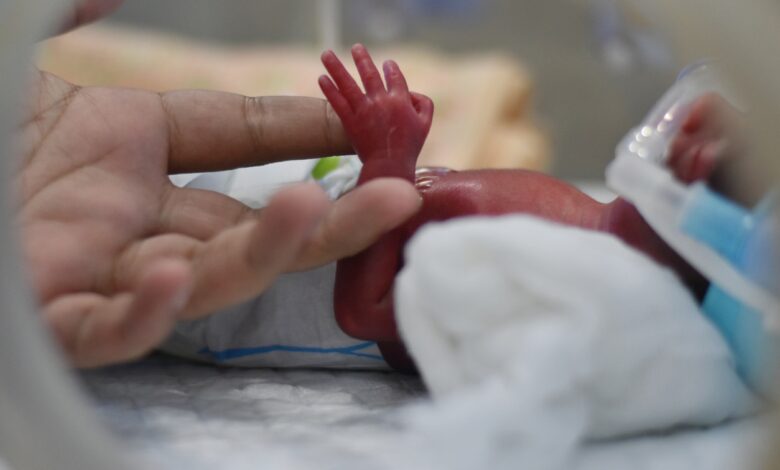Preemie Developmental Milestones: What To Expect

The birth of a premature baby can undoubtedly cause a significant change of plans for you and your family. Your child’s early arrival requires a little adjustment. If your bundle of joy arrives earlier than expected, it’s important to have realistic expectations as your preemie grows, develops, and prepares for home.
If your baby is born before 37 weeks of pregnancy, they are considered premature.1 Because your baby grows and develops outside the protective environment of the amniotic sac, they may need more support and medical care than babies born closer to their due date. There are different terms used to differentiate the degree of prematurity:5
- Late preterm babies are born between 34 and 36 weeks of pregnancy.5 Most premature babies fall into this category.4
- Moderately preterm babies are born between 32 and 34 weeks of pregnancy.
- Very preterm babies was born before 32 weeks’ gestation.
- Extremely preterm babies was born at or below 25 weeks of gestation.5
Besides the gestational age classification, there are specific weight categories used to classify premature baby weight:17
- Low birth weight means that a baby weighs less than 2,500 grams or 5 pounds, 8 ounces.
- Very low birth weight means that a baby weighs less than 1,500 grams or 3 pounds 5 ounces.
- Very low birth weight means a baby weighs less than 1,000 grams or 2 pounds 3 ounces. These babies are also called micro preemies.6
Micro preemies are very fragile and at the highest risk for complications.2
The adjusted age is calculated by subtracting the number of weeks your baby was born early from their actual age. If your baby is now 4 months old and was born two months (8 weeks) early, their adjusted age is 2 months.8 If you compare a 4-month-old baby born at 40 weeks gestation to your preemie baby, you may see a difference in their developmental skills. For example, your baby may not yet smile to get your attention because this skill doesn’t usually occur until 4 months.12
All babies develop at their own pace; however, if your baby is a preemie, their adjusted age will give you a more realistic idea of when they may achieve certain developmental milestones in the first two years.9 During this time, most preemies experience catch-up growth.10 If your baby doesn’t seem to be hitting certain milestones by age 2, their healthcare provider may refer them to specialists where they can receive additional support.9
Growth charts are tools that health care providers use to assess trends in your baby’s weight, length, and head circumference over a period of time. This helps them identify any inconsistencies based on your child’s expected growth.18
The World Health Organization (WHO) growth chart is used for babies born at term, and the Fenton growth chart is used for preemies. Both include measurements of weight, length, and head circumference, but the WHO growth chart measures monthly increments, while the Fenton growth chart measures weeks. The Fenton growth chart begins at 22 weeks and ends at 50 weeks. Once your baby reaches 40 weeks gestational age, the same charts can be used to track their growth. After your baby graduates from the Fenton growth chart, their adjusted age should be used to plot their growth on the WHO growth chart until they are 2.10

Whether your preemie grows more slowly depends on the severity of the medical complications they are experiencing. Being born early does not necessarily result in slower growth because your baby continues to develop as if it were a growing fetus. What can cause slower growth are health complications such as breathing issues, weight gain challenges, and feeding difficulties.11,14
If your baby was born early, there are some preemie milestones to look for as they grow and develop.
At 26 weeks, your baby can open their eyes periodically, but to reduce overstimulation, their environment will be darkened with a covered incubator while they sleep and grow.11 Nutrition and hydration are provided by IV fluids. A small IV (intravenous) tube is inserted into a vein in the best location for reliable and stable access. It can be on the hands, feet, scalp, or even through your baby’s umbilical cord stump. These IV fluids will support your preemie’s growth until the medical team determines they are ready for full feedings.13
They will likely develop apnea of prematurity, which means they pause between breaths because the part of their brain responsible for triggering breaths is not fully developed. As they get older, it will decrease, and your baby’s doctors will make sure they grow out of it before they go home. Your baby can hear your voice and sounds in their environment because their ears are fully developed. Their skin is immature and very fragile. The NICU staff will teach you how to hold your baby to avoid overstimulation.11
Your baby may blink, and their eyebrows and eyelashes are starting to develop. You may also find that they respond when they hear your voice during times of alertness. They are learning to suck, but it will take some time before they can eat by mouth. This happens when they are able to coordinate sucking, swallowing, and breathing.11 If the medical team determines they are ready, they will be fed through a nasogastric or orogastric tube inserted into their nose or mouth that goes down their esophagus and into their stomach.13 If your preemie is medically stable, you can start holding them on your chest skin-to-skin, also known as kangaroo care.11
At 28-30 weeks, your baby’s muscle tone increases, and they will move their arms and legs more often. They may also close their eyes in response to bright light. Singing or talking to your baby during periods of alertness is a great way to bond, as your voice is familiar to them. The rooting reflex, which causes your baby to turn his mouth toward a pacifier or finger touching his cheek, may begin to develop. This reflex will help your baby find food sources when ready to breastfeed or bottle feed.11
Between 30-33 weeks, you may notice that your preemie’s movements are smoother as they get stronger. Their sleep patterns become more regular, alternating between deep sleep and periods of alertness. Your baby may also begin to focus on your face and respond more clearly to your voice. They can also start soothing themselves by bringing their hands to their mouths.11
At 33-36 weeks, your baby develops distinct states of activity, such as deep sleep, active sleep, quiet alertness, and active alertness. Telling your baby what you’re going to do will help them anticipate diaper changes.11 They can also be gradually moved from the incubator to an open crib as long as they can maintain a normal body temperature. This ability depends on their weight and gestational age.15 Their coordination of sucking, swallowing, and breathing may be enough for them to start feeding. Your baby’s medical team will determine if they are ready. Oral feeding is started gradually because it requires your baby to expend extra energy.14
When your preemie reaches 37 weeks, bringing them home may be on the horizon. To be fully prepared, the medical team will make sure your NICU baby has met all of their discharge goals. Depending on the facility, this may include completing tests such as a hearing test and a car seat test. For this test, your baby will sit in his car seat while his vital signs are assessed to make sure he can tolerate sitting there for the ride home. Parent education, such as training in cardiopulmonary resuscitation (CPR), administering medications, or using home medical equipment as needed, is also provided.16
If your baby arrives early, it’s important to know that they may have some preemie-specific challenges to overcome. It can be tempting to compare your baby’s developmental achievements (such as rolling over, sitting up, crawling, etc.) to others of the same age as they get older. But be realistic and keep in mind their appropriate age. Remember that every baby, born early or within days of their due date, is on a unique journey toward their developmental milestones. When your little one is ready, the celebration will be super sweet!





